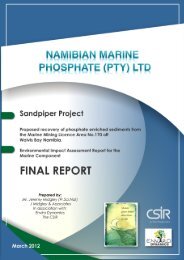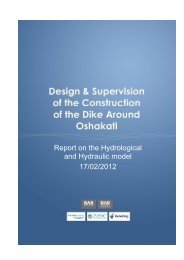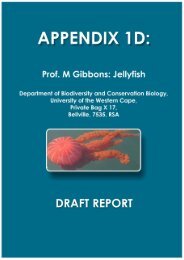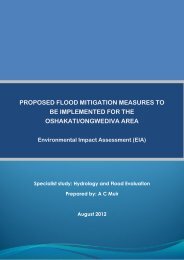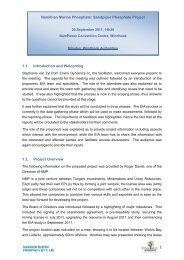Fisheries - Enviro Dynamics Namibia
Fisheries - Enviro Dynamics Namibia
Fisheries - Enviro Dynamics Namibia
You also want an ePaper? Increase the reach of your titles
YUMPU automatically turns print PDFs into web optimized ePapers that Google loves.
F I S H E R I E S , M A M M A L S A N D S E A B I R D S S P E C I A L I S T S T U D Y<br />
diversity (relative to non-upwelling environments). These stocks have traditionally supported<br />
intensive fishing activities. Although varying in importance at different times in history, fisheries<br />
have focused on demersal species, small pelagic species, large migratory pelagic fish, linefish<br />
(caught both commercially and recreationally) and crustacean resources (e.g. lobster and crabs).<br />
The following chapter is a review of the ecologically important species that may be affected by<br />
mining of marine phosphate in <strong>Namibia</strong>. For each species the spatial distribution, recruitment to<br />
the commercial fisheries and spawning behaviour are considered.<br />
2.1 PELAGIC FISH SPECIES<br />
2.1.1 Horse mackerel<br />
Off <strong>Namibia</strong> horse mackerel<br />
Trachurus trachurus capensis<br />
generally occur in waters between<br />
200 – 1000 m depth (Crawford et al.<br />
1987) (Figure 1). Adults are found<br />
mostly north of 21°S. Here spawning<br />
is highest between October and<br />
March in the mixing zone between<br />
warm oceanic water and cool coastal<br />
waters (O’Toole 1977). Nursery<br />
grounds exist adjacent to these<br />
spawning grounds but closer to<br />
shore. Juveniles migrate south to<br />
Walvis Bay especially in winter.<br />
Maturing fish then move offshore<br />
and migrate north to spawn (Boyer<br />
and Hampton 2001a). Horse<br />
mackerel of up to two years of age<br />
feed predominantly on zooplankton<br />
that they consume near the sea<br />
surface. Research in the 1980s found<br />
that off <strong>Namibia</strong> 95% of the diet of<br />
adult horse mackerel comprised<br />
euphausiid shrimps (Konchina 1986<br />
cited in Boyer and Hampton 2001a).<br />
This is in contrast to horse mackerel<br />
occurring off South Africa which feed<br />
opportunistically on euphausiids,<br />
polychaete worms, squid,<br />
crustaceans and fish such as bearded<br />
goby Sufflogobius bibartus (Konchina<br />
1986 cited in Boyer and Hampton<br />
2001a). Since the trophic structure of<br />
the northern Benguela system off<br />
<strong>Namibia</strong> has altered substantially in<br />
the last two decades (Kirkman 2007,<br />
Final Report<br />
<strong>Namibia</strong>n Marine Phosphate (Pty) Ltd.<br />
Figure 2. Distribution of sardine stocks in the Benguela<br />
region<br />
Page 13



